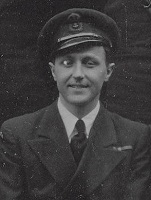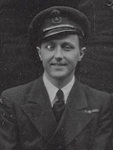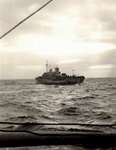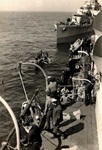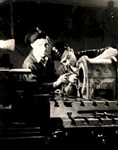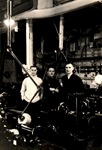|
In memory of those who have Crossed the Bar
Ships served in:
(EB01) CPO Eric Baird (EB02) HMS Hotspur (EB03) HMS Banff Y43 (EB04) HMS Indomitable (EB05) Unknown sailing vessel
(EB06) USN destroyer in the River Foyle, Northern Ireland (EB07) RMS Queen Mary (EB08) Unknown corvette
(EB09) Whaler races in Bermuda (EB10) Boat transfer between HMCS ORILLIA K119 and an unknown destroyer (EB11) Iceland as seen from HMCS ORILLIA K119
(EB12) HMCS ORILLIA, STBD side looking forward (EB13) Frankie Stark, STO PO, an iced-up HMCS ORILLIA (EB14) Chief White, Mate and Commanding Officer Bob Briggs, HMCS ORILLIA K119 (EB15) A few crew members on HMCS ORILLIA K119
(EB16) Jimmy Buck and Harold in Heavy Shop (EB17) Burt, Eric Baird, and Percy Cunningham in the Light Shop (EB18) Two unknown Petty Officer on a train
(EB19) Captured French Schooners at St. John's, Newfoundland
RE: photo EB19 - The following was submitted by Donald (Bud) Rose - "The two ships are moored at the South / West corner of St. John's harbour, across from what would become in 1940 - the Royal Canadian Navy Dock Yard. In 1941, the Nfld Dockyard underwent extensive and ongoing renovations to bring the yard up to war time requirements, and the first graving dock which was built of wood in 1882 and re-built with concrete in 1925 was again upgraded as required from 1941 to 1945. This area also became the RCN - N A D during WW II, and today is occupied by the Canadian Coast Guard. The large square building in the top right hand corner of the photo is the Nfld Hotel, completed and opened in 1926. This indicates that this photo was taken post 1926. The area in which the vessels are moored was renovated in 1940. To be more exact, we can look at the reason they were there. In 1883 the Nfld cod fishery was in serious decline. The main reason given was the extensive fishing on the Nfld grand banks by the French and the Norwegians - which were supported by the French. To counteract this, Nfld enacted the "Bait Protection Act" which prohibited foreign fishing vessels from obtaining any bait from Nfld. The bait was Capelin - Squid & Herring - usually only available inside Newfoundland's territorial waters. Any fishermen caught selling bait to foreigners were arrested and any foreign vessel caught inside territorial waters was seized. In 1922 world historical events had an impact. The French islands on St. Pierre & Miquelon are situated less than 20 miles from Nfld.'s southern shore. The Nfld bait protection act had a great impact on their economy, which changed in 1922. Two major events occurred in that year; the United States introduced prohibition and France repealed their 'Act' which prohibited the import of foreign liquors into French territory. The end result was St. Pierre & Miquelon becoming the main shipping point for "illegal" wines and spirts entering the U S. With this re-vitalization of their economy, they virtually abandon the fishery. In 1933 the U S repealed the prohibition act and the economy of St. Pierre & Miquelon collapsed. By 1934 they were back to fishing and illegally buying bait from Nfld fishermen, and those who were caught had their vessels seized [which were towed to St. John's]"
HMCS RESTIGOUCHE H00
Photos courtesy of Roger Clarke
|

